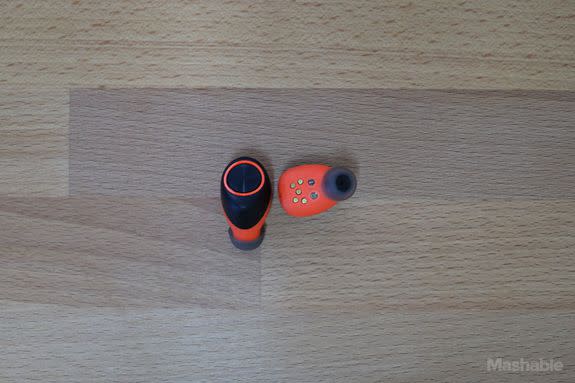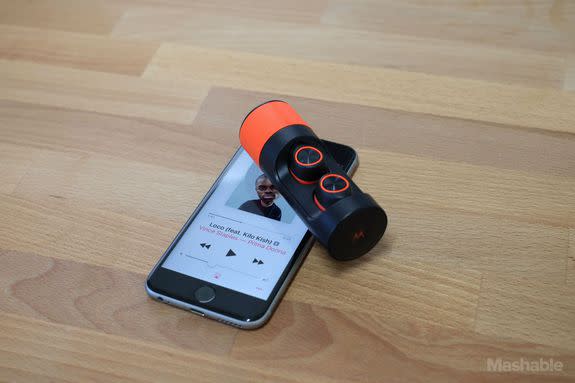Motorola's cable-free earbuds fall short of the great wireless promise

What a time to be alive! Hot on the heels of Apple banishing the headphone jack from the iPhone 7 and 7 Plus, wireless headphones and earbuds are sure to garner a lot of attention.
For the past two weeks, I’ve been using the $250 Motorola VerveOnes+ wireless earbuds. There’s no cord to be found on the two orange buds. To be clear, the VerveOnes+ aren’t from the Lenovo owned Motorola. They are from the other Motorola that makes stuff like baby monitors and, through a licensing deal with Binatone, headphones.
SEE ALSO: Don't worry about how they look — Apple's AirPods are excellent earphones
During that time, I’ve thought I lost one or both earbuds, I’ve jammed to the new Vince Staples album, and I’ve grown increasingly frustrated with managing the VerveOnes+ connection between multiple devices.
In our new world where iPhones shun the headphone jack, are the VerveOnes+ the wireless headphones you should rock? Most likely not.
Unboxing the Motorola VerveOnes+ wireless earbuds.
A video posted by Jason Cipriani (@mrcippy) on Sep 8, 2016 at 1:57pm PDT
Earbuds linked
The initial pairing process of the VerveOnes+ to your smartphone or computer is a straightforward affair. Remove the left earbud from the charging case, put it in your ear, listen for a chime and voice stating the earpiece is in pairing mode and then follow the standard pairing procedure on your phone. Then you remove the right earbud, place it in your ear, wait for a soothing voice to tell you “Earbuds linked” and then you can begin listening to music as you would any other pair of headphones.
The left earbud connects to your device, and the right earbud connects to the left. Meaning, you have to start in this same order every time you put the earbuds in. You can put the right earbud in first, but it just beeps at you letting you know it needs its buddy, the left earbud.

Image: JASON CIPRIANI/MASHABLE
This is just how most wireless earbuds work right now, using one as the gateway to the music device and the other a second speaker of sorts.
You can remove the right earbud, opting to use only the left as a microphone to take calls on or continue listening to music while still being able to hear your surroundings.
Every time you put the earbuds in, you’re given the remaining battery life. When fully charged, the earbuds will provide three hours of playback. A quick top off from the charging case can add up to 12 hours of playback.
Pair, unpair. Connect, reconnect.

Image: JASON CIPRIANI/MASHABLE
The most frustrating part of my time with VerveOnes+ came when using the earbuds in the presence of devices to which I had previously paired the earbuds.
Following the left-earbud-first process with more than one paired device in near proximity (my iPhone and iPad Pro, for example) would either lead to the earbud not connecting at all, or almost always connecting to the device I didn’t want to use. The only solution to this was to turn off Bluetooth on the device I wasn’t using, place the headphones back in the carrying case for a few seconds, and then start the connection process all over again.
I had to do this dance quite often. On a few occasions after removing the earbuds from my ears and putting them back in a short time later, they would fail to connect to the last device I had connected to them. Placing the VerveOnes+ back in the case and then back in my ears — in the right order — always did the trick.
Instead of untangling wired headphone cords — the bane of my existence when traveling — now I have to worry about misplacing a single earbud. Something I can attest to having experienced on a recent trip to California. On two different occasions I had removed one or both earbuds to hear an announcement or order lunch, only to have a feeling of slight panic the entire time the earbud wasn’t in my ear or the charging case.
Thankfully, the VerveLife iPhone or Android app will track the location of the last place your headphones were connected to your phone, making it easy to see you lost them at home, and not the office. Too bad you can’t play a short, but high volume noise on an earbud to help locate it. A GPS signal does very little good when a tiny earbud is crammed between couch cushions.
Intended places of use

Image: JASON CIPRIANI/MASHABLE
The VerveOnes+ are designed for active users. That is, people who like to workout, run, or ride a bike. They are IP57 for sweat and water resistance.
The company, I’m told, is confident the headphones will perform as expected.
After experiencing an issue with constant dropouts and the two earbuds getting out of sync, I reached out to Motorola. According to a company representative, the VerveOnes+ will experience such interference in “extremely busy environments like major airports during peak times.” Indeed, I was in an airport when the issue was most prominent.
For what it’s worth, on the return flight home I didn’t experience the same issue. The company, I’m told, is confident the headphones will perform as expected — that is with little to no dropouts or interference — in the intended places of use “outdoors, at home, [and] at the gym.”
Of course, the bulk of my use was in a combination of those environments and I rarely encountered an issue. I found no fault with the sound quality or volume level. If you do want to fine tune the sound, you can do so by tinkering with the companion app’s equalizer, which syncs your adjustments to the earbuds.

Image: screenshot: JASON CIPRIANI/MASHABLE

Image: SCREENSHOT: JASON CIPRIANI/MASHABLE
Having tested the Jaybird Freedom wireless earbuds just a few months ago, coincidentally, during a trip to California, I can say I didn’t experience the same dropout issues and connectivity problems when in an airport. Granted, the Jaybirds have a wire connecting the two earbuds whereas the VerveOnes+ are forging ahead into uncharted territories.
Almost ready, but not quite there yet

Image: jason cipriani/mashableJASON CIPRIANI/MASHABLE
It’s hard to be overly critical of a device that’s designed to get ahead of the current trend, clearing the way for truly wireless earbuds as a mainstream accessory.
If you take the company’s stance of providing a quality experience when the VerveOnes+ are used at home or the gym, then the VerveOnes+ deliver. But asking someone to pay $250 for earbuds that might not always provide the best experience based on how many people are around you is a stretch.
Motorola VerveOnes+
The Good
Lightweight, comfortable • Portable charger doubles as a carrying case • Completely wireless earbuds are just cool
The Bad
Finicky Bluetooth connection • Not all that comfortable
The Bottom Line
Completely wireless and waterproof design are the key selling points of an otherwise mediocre pair of earbuds.

 Yahoo News
Yahoo News